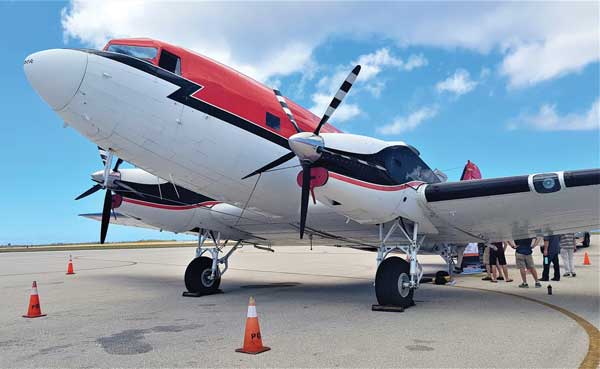Saipan nautical data gets an update

The DC-Turbo still stands strong after eight decades in operation and use. (Bea Cabrera)
Have you seen yet a red-and-white airplane with fixed-wing propellers that has been circling Saipan the past couple of days?
That’s called a DC-Turbo aircraft and it is doing a hydrographic survey of Saipan. That means it is collecting data about the Saipan coastline to help mariners and ships sail safely through our waters.
The last hydrographic survey done on Saipan was 10 years ago and many things under the water may have changed since then. A new, updated picture of the Saipan coastline will guide today’s mariners on what lurks be-neath the waves.
Arthur Scott Davidson, director of Navigation Support Division of NAVAL Oceanographic Office in Mississippi, said that the plane and his 11-man team arrived on Saipan in early May to collect data for the safety of navigation.
“…We work for the [U.S.] Navy and the prepositioned ships that are here wanted updated charts for the shipping industry. …They need modern charts to be able to anchor here and other ships that come in and out… Saipan is the only purview for this survey,” he said.
The data collected is then turned over to the National Oceanic and Atmospheric Administration who is the chart-ing authority for the Northern Marianas, and it will then update the nautical chart and make these charts available for purchase.
Davidson concedes that collecting the data and interpreting it is a drawn-out process.
“We collect the data here, then data gets back to Mississippi, and a group of scientists will go through it with a fine-toothed comb to make sure it’s absolutely right,” he said.
The survey done on Saipan 10 years ago was done by a different team.
NOA will compare the results of this latest survey and the last survey and do a comparison..
“They are the ones that will give you an official word on how [the underwater topography has] changed,” he said.
To make the data collection fast and accurate, they use an equipment called the Coastal Zone Mapping and & Im-aging Lidar System. This tool provides hydrographic near-shore topographic data collection using 10,000 Hz Pulse Rate Laser that is attached to the plane and activated when it flies around the island.
Site lead David Burke is responsible for collating and reviewing all the data. “I manage the flight crew and initial review all data collected before we turn in over to the NAVAL Oceanographic Office data manager.
He assured that the equipment they have can stand the test of the worst environment one can possibly have at the back of the airplane: heat, dust, humidity, and vibration.
His team is made up of highly trained individuals who know the equipment and can troubleshoot on the fly. “They are really the reason why we are able to perform efficiently and get the job done and get the data that we need,” Burke said.
Davidson and his team will be on island for 18 days and are ahead of schedule. “Your weather is so beautiful and the airport worked with us so well that we are way ahead of schedule. …We have already collected all the data of water around Saipan and now we are flying over places that the lasers didn’t get,” he said.
“Part of that was the ships that are anchored. When we flew over them, we got the ship but not what was under it so we plan to fly on a different tide when the ship would’ve turned, so now we can fly where it used to be and col-lect that data,” he added.
Depending on the day, his team flies out for six hours a day but they can also do eight hours.
For such a significant study on a high-tech expedition, why use an old plane?
“This plane is dedicated to this kind of data collection work,” said the plane’s pilot, Stephen Kaizer.
With built-in turbine engines, a few modifications to the airframe and new avionics or electrical system, “it’s ba-sically a brand new airplane with the old design,” Kaizer said.
“There aren’t many airplanes that this airplane can do as far as range, capacity, ease of maintenance, and speed go. It’s built in the ’40s, by a bunch of housewives and you can’t beat that,” he added.























